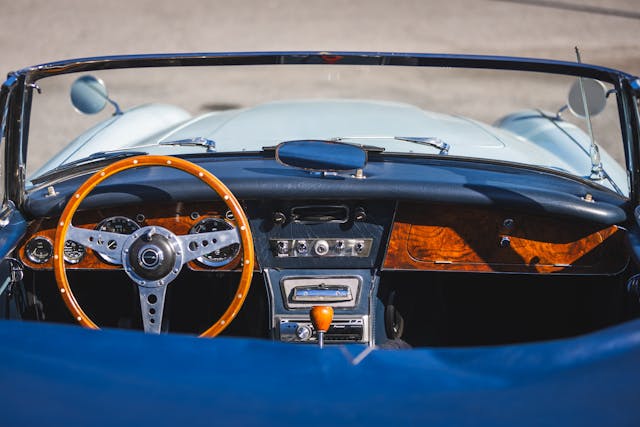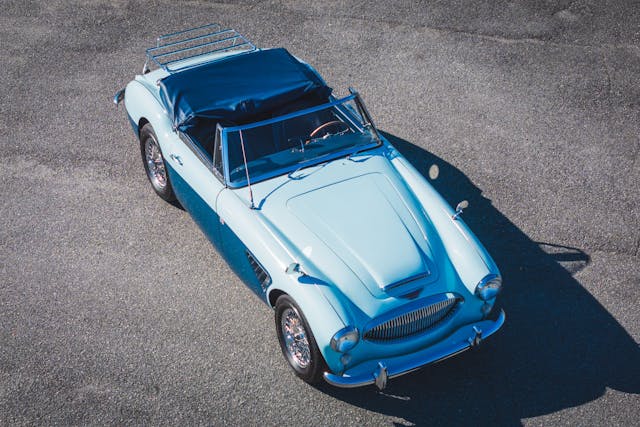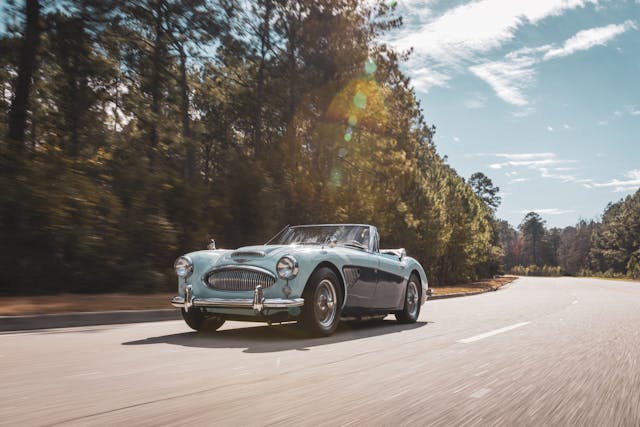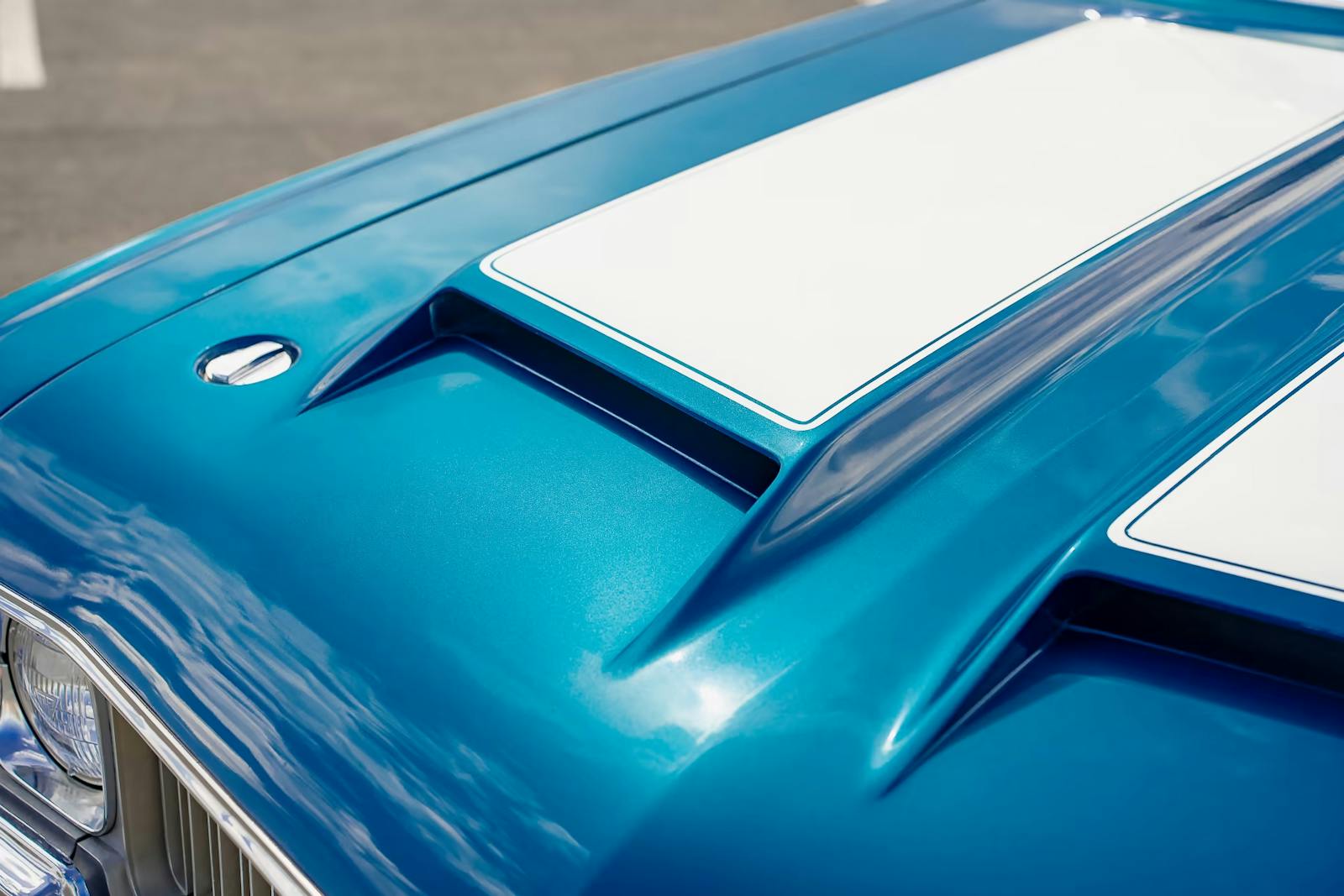Media | Articles
For the Austin-Healey 3000 Mk III, Appreciation is on the Open Road
The door latch on the Austin-Healey 3000 Mk III offers a satisfying pop when I depress the release. Feather-light as if built for an airplane, the door swings open with ease, and I slide into the driver’s seat of this handsome British convertible. I gaze over the woodgrain dash and Smiths gauges at the view ahead—the lithe fenders, long hood, and low windshield read as much piston-engine fighter plane as they do ’60s sports car. The 2.9-liter straight-six cranks to life, settling into a low thrum. It’s a blue-sky beautiful day, perfect for an open-air drive.

The aircraft analogy might be relevant for many British drop-tops of this era, but it’s particularly apt for Austin-Healey. Donald Healey, the company’s founder, was an aviator in the Royal Flying Corps in World War I before he turned his attention to cars. The 3000, though cheerful in countenance compared to its more glamorous Jaguar E-Type contemporary, carries a bit of warbird ethos—taut skin, tight proportions, and just enough visual aggression wrapped over durable bits built to stand up to the rigors of competition.
And compete it did. If you attended a sports car race in period, whether Le Mans, Sebring, an SCCA event, or a rally, chances were good you’d see a 3000. They continue to be a popular choice in vintage racing, as well.

On the road, this 1964 Mk III (available on Hagerty Marketplace) asserts itself as a capable, engaging sports car. I ease off the clutch, roll into the throttle, and the torquey six pulls with more verve than I expect. At around 2500 pounds and with 150 horsepower and 173 lb-ft of torque, aided by a shorter 3.9:1 rear-end gear ratio on overdrive-equipped examples, the later Mk III is eager, if no longer considered fast. And that sound—the exhaust emits an addictive, throaty urgency in the upper half of the rev range that encourages you to keep up the pace, if only to hear the roar.
Nearly 60 years on, this Healey’s sporting intent remains clear. Shifts of the four-speed manual transmission require a deliberate hand, but the gates are clearly defined, the lever’s action precise and mechanical. Once committed to a corner, the lovely wood-and-polished-metal steering wheel offers good feedback. The brake pedal requires a heavy foot, though the front discs and rear drums effectively woah the Healey down. Once you get acclimated with the controls and step up the pace, the chassis reveals that you’re wheeling a willing partner.
Marketplace
Buy and sell classics with confidence

British roadsters aren’t universally known for accommodating all sizes, but the Healey’s interior is reasonably roomy for the class. The upright seatbacks take some getting used to, though they are effective at keeping you in place while cornering. Those vestigial rear seats, hidden as they are under the convertible top’s tonneau cover, are a welcome bit of extra luggage space. Door height isn’t as cut-down as some sports cars from the era; it’s low enough to contribute to the cabin’s airiness (and rest your elbow on) without feeling wide open.

You’re surrounded with visual appeal—the cleanly designed interior is finished with materials that please the eye and feel good to the touch. The 1964 update from the BJ7 to the BJ8 model incorporated an all-new interior that yielded the surfaces you see here, along with fresh gauges and the addition of wood paneling to the dash.
The 3000, named for its (nearly) three-liter BMC C-series engine, was introduced in 1959 as an evolution of the Austin Healey 100-6. The 124-hp Mk I was available in two-seat and 2+2 configuration (both with a removable soft top) and featured front disc brakes as standard. The Mk II arrived in 1961, receiving triple SU HS4 carburetors (boosting the car’s horsepower to 132), and a grille and intake redesign. For 1962, the model saw a return to dual SU carbs, while a convertible top and roll-up windows arrived on the scene at the same time that Healey did away with the two-seat variant.

The Mk III debuted in early 1964. In addition to the aforementioned refreshed interior, which now came standard with Ambla vinyl (leather became an option), the engine reached its most potent form: A new camshaft, new valve springs, larger carburetors, and a revised exhaust gave the BMC C-series that healthy bump over the BJ7 Mk II, to 150 hp. Power-assisted braking became standard, and in May of 1964 the rear suspension changed to a six-leaf setup, and the axle was located with a pair of radius arms instead of a Panhard bar. This added some height in the rear to help reduce scraping of the low-slung exhaust.

Much like the British segment as a whole, values for the Mk III 3000 are retreating ever so slightly. That said, our analysts have observed examples sell well above their condition value without clear reason. These cars do have a passionate following, and when the right car finds a couple of interested buyers in the same room, bidding can take off. Driver-quality cars have long lived in the under $50K range, with #3 (Good)-condition cars currently sitting at $44,100 and #4 (Fair) examples valued at $27,400.
As when they were new, these Healeys slot between the upmarket Jaguar E-Type and myriad entry-level Brit roadsters. A #3 1966 Series I E-Type roadster—a car with 115 more horsepower and, of course, E-Type allure—comes in at $126K, well north of #1 (Concours) value for the Mk III. In the other direction, a healthy, well-sorted #2 (Excellent) 1970 Triumph TR6 lands at $31,700, just between #3 and #4 conditions for the Healey.
More than 17,000 Mk III cars were produced, far and away the largest run of the 3000’s iterations. Healey’s audience was 90 percent American by 1963, so most of the cars that remain are likely Stateside. As with any car, a well-maintained example can save you from surprises; this is especially true with “Big Healeys,” as proper restoration can get expensive.

3000 Mk III Healey ownership demographics currently skew heavily toward baby boomers, but the times, they are a changin’. Millennials and Gen Z have each seen their share of buyers seeking quotes nearly triple since 2019. Quote count dipped slightly in 2023 but has been relatively consistent over the last five years, so while it remains to be seen whether interest from a younger cohort will help with Healey values, signs do point to these cars holding the attention of a younger generation of enthusiasts.
A perfect late winter’s day and a charming open-topped car have long been a hard-to-beat combination. Austin-Healey’s 3000 Mk III blends a reasonably affordable classic-car entry point with an engaging drive and gorgeous lines to match. The 3000 Mk III is one you buy to enjoy, and enjoy it you will.

***
Check out the Hagerty Media homepage so you don’t miss a single story, or better yet, bookmark it. To get our best stories delivered right to your inbox, subscribe to our newsletters.










You can lay this pricing directly at Ferrari’s feet. In the 90’s when Ferraris exploded in price and started becoming unaffordable people sought out alternatives. Enter the Jaguar E-Type. They we comparatively abundant and affordable. When demand exploded for them, so did the price. The next comparable cars were the big Healeys. Same result. When I sold my 61 MkII tri-carb, I thought I made a good deal. Sold it to buy a BMW 2002 that was the biggest POS I’ve ever owned. A decision I rue to this day….
Up here in the great white north the Healey was just another British car which received a SBC. When a BMC product arrived at the doorstep of the shop I worked at during high school for a tune-up the question was “327 or will a 283 be adequate”.
As for the BMW 2002 a tune-up on one of those included replacing the rusted out front fenders and repairing the rear suspension towers. I don’t think any Japanese or European vehicle had any form of fender liner back then and US unibody cars were no better. During the winter the slush would get hurled into the front door area. When it froze the door required a tug than bent the the lower front corner outwards. After a couple of years rust created holes in the tops of the fenders. We didn’t know about the aero advantage then.
Good times!
You sold a 61 MkII tri-carb for a bmw 2002? Poor fella. And I thought I’ve made some poor choices in my life……..
The 3000 is a great driving experience – few things can beat its combination of classic good looks, great exhaust note, reasonable power and reasonable comfort. When folks see my collection, I always tell them that if you are thinking about one classic car to buy, the AH3000 is hard to beat – the bonus is that parts availability and an active club and online community makes the ownership experience much easier than many other European marques from the same time period.
The bonus part for the AH is that the oldest parts house in Britain is actually making new parts for the cars. One could theoretically (with enough £££) build a brand new Healey from the ground up. Easier though to get one already built, and much cheaper too. My BT7 tri-carb went to my son for a Christmas present 2 years ago, and my original purchase (2nd owner) has been converted to a tri-carb as well. Fantastic cars!!
Had a ’55 100/4 back in the early ’60s. Sure do miss that car. Wish I could afford one now.
My neighbor had a Healey , not that he deserved it. The kind of guy that from the first ‘how ya doin’ you know is best to avoid and things go downhill from there. That car sure looked good sitting in his garage as it always did. My place was on the banks of the Delaware and with what could be best described as a flash flood put it underwater, the 3000 went under too. The water did recede relatively quickly however. I dreamed of buying it then. Not to restore but to do a whatever will work to make it work driver. Get out the tape measure, scrounge for parts, call in some favors. That never happened and even if I had offered to buy it I’m sure he would have asked for as much as a clean running example. He would rather hold on to it just.. because. Still it would have been something to drive it mix and match components and all. A lot of pretty scenery and some great roads out there to take on a late winter blue-sky day.
The people who remember these cars from their youth are aging out. Prices should fall for lots of cars of this era (not talking about the Ferraris of the world).
As a kid I fell profoundly in love with the AH 100 and, after getting out of the Army, almost bought a ’67 AH3000. It was BRG with a tan interior but I got really dumb and bought a new Fiat 124 instead. I still think they are beautiful machines but I never managed to own one.
Looks good. I would love to drive one some day.
The first car I ever restored was in the late 70’s – a 1968 MG Midget. Life changes ultimately meant its sale. But in the late 90’s I found myself in the position to afford a good classic. Liking their look and thinking it would be a great step up, I thought to purchase an AH BJ8 MKIII. That is, until I drove one. I found the performance uninspiring. The seats were essentially the same as the Midget. The transmission had the same clatter. Not a comfortable car nor great handling. Disappointed, I sought alternatives.
I discovering Jags, the XK series in particular. I ended up buying an XK150S. Yes, more expensive. But leagues different in performance and comfort. Never looked back.
Some years ago, a friend from the East Coast stored his 3000 Mk III in our Michigan garage for a few months, while he waited to arrange transport back east. He invited me to drive it at will, to keep it well exercised, and I happily did. I was blown away by how superior it was to the garden variety British and Italian sports cars I’d driven in the 1980s and I’ve had a soft spot for them since.
For those of us that are retired and not in the same income bracket.
My 1969 MGB Mark III if my summer roadster.
I did have the opportunity to drive an Austin-Healey 3000 Mk III once, but I being 6′ 2″ found the windscreen too high, and I found it hard to see over the hood since I slid down in the bucket seat.
Back in 1954 while sitting on a beach at Clearlake, Ca I heard an unusual engine sound. Turning around I saw the most beautiful car. It was an Austin Healey 100 4 in Healey Blue metallic. It was my first love of my life and hoped to have one someday. I’m 86 now and have had 2 AH 100 4 and 1AH 3000. I still have my ’56 BN2 100M I’ve had for 60yrs! Healey Blue of course .
Nice article. I have owned a 1960 BN7 since 2000. Restored in 1989-90, it’s finally in line for a respray after I did the engine 5 years ago the way I wanted it–Denis Welch 84mm pistons and DWR1 cam with hollow lifters, DWR flywheel, and oil pump. With the respray, I’m adding wing vents, and a rally grille with oil cooler vents below. Can’t wait to get it back on the road. Unless I decide to add another carb and a header…
I had owned Austin Healey 3000s for almost 50 years. I usually owned 3 at one time. The first was a 1964 BJ7 that I bought when I returned from Vietnam in July 1968. I did a complete ground up restoration on a 1962 Tri-carb BT7 (4-seater) finishing in 1997. I built the car with features that I wanted. The engine dynoed at 170 HP. It was really fun to drive. Great car! I did a complete ground up restoration on a 1962 Tri-carb BN7 (2-seater) to all original specifications that was completed in 2014. It sold at auction in Auburn, IN that same year. The 1964 sold in 2003 and went to Sweden. The 4-seater was the last to sell and it went to California in 2018. Great cars, wonderful experiences, and a life well-lived. I drove these cars all over the country. No regrets, but they are a “young man’s” car.
In the 80s a friend of a friend of mine used to show up to gatherings in his Dad’s 3000. His father bought the car new as he was a doctor and drove it a lot thus the car looked a bit worn and tired (it was identical to the one pictured less the dark blue two-tone) This was in the Vancouver BC era so the was actually in pretty good shape as it wasn’t rusty and damp but just faded paint and worn interior. One afternoon on an outing I was with my aforementioned friend in his brand new Mustang GT and his buddy and his girl showed up in the Healey. Friend one decides to show off his new 5.0 and make a bit of a race of it. To my shock the Healey stayed with us side by side. Looking at that roadster at full speed in the sunlight won me over. I have been a fan of anything Healey since. as an aside, I saw the car not too many years ago at a local show. The friend of the friend who I believe became a draftsman has a brother that is a local auto journalist and the brothers have returned the Healey to it’s former glory. It as always is a work of art. It can be seen at the All British Field meet in Vancouver annually. I thought it was a nice tribute to their dad as well being a thank you to him for letting his sons drive such an iconic car around on nice BC days. Not every father would let the kids take out the Healey.
“To my shock the Healey stayed with us side by side.”
I crewed for a D Production AH 3000 in the 60’s – it was nothing for that car to stay planted on the rear bumper of a B Production Corvette. On good days we could pull even in the corners and on really good days we could get half a car length ahead. Lord that was fun . . .
I lived in San Diego 40 years ago near SDSU, and the older lady (70?) next door had a 3000 as her daily driver. Never garaged, no back window, the top was never let down. To her, it was “just a car.” My bedroom window was right next to her driveway. What a beautiful sounding alarm clock!